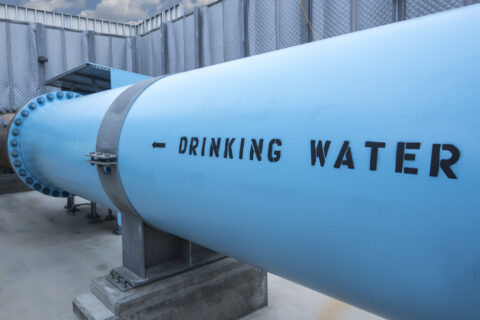On November 30, 2023, the U.S. Environmental Protection Agency (EPA) released a proposed rule establishing National Primary Drinking Water Regulations for Lead and Copper: Improvements (LCRI). The proposed rule builds on the Lead and Copper Rule Revisions finalized in 2021.
The EPA website provides additional information about the proposed rule, including a summary and fact sheets. EPA is accepting comments on the proposed rule through Feb. 5. EPA has stated the agency intends to finalize the LCRI by October 2024. The compliance date for communities is three years once the rule is final and published in the Federal Register.
Here is some key information that local leaders need to know about the proposed rule.
Initial Deadline for Lead Service Line Inventory Remains October 16, 2024
As established by the Lead and Copper Rule Revisions, all community water systems and non-transient non-community water systems (such as schools) are required to provide an initial inventory of lead service lines to states by Oct. 16, 2024. This deadline is not changed with the proposed LCRI; however, under the LCRI, communities would have to develop an updated baseline inventory by the compliance date. Additionally, the LCRI would require communities to update their inventory annually, use a validation process to ensure the inventory is accurate, and identify all service lines of unknown materials by the replacement deadline.
Many communities are making progress toward completing the inventory. Federal funding and financing are available through the Drinking Water State Revolving Fund, including under the Bipartisan Infrastructure Law, which provided $15 billion specifically for lead pipe inventories and replacement activities.
EPA developed an inventory template for local governments, which provides instructions for the kind of information that needs to be collected in the inventory.
Requirement of 100% Lead Service Line Replacement Within 10 Years
The EPA is proposing a mandatory replacement requirement of all lead and galvanized service lines under a water system’s control within 10 years.
The proposed rule would require states to set shorter deadlines for individual water systems where the state determines that it is feasible (e.g., by taking into account the number of lead and galvanized service lines in a system’s inventory).
Additionally, the proposed rule provides deferred deadlines for water systems with a high prevalence or proportion of lead and galvanized service lines in their system, unless the state determines that the 10-year deadline or a shorter deadline is feasible. EPA is proposing two pathways for water systems to defer their service line replacement deadline past 10 years.
Pathway 1: Systems with an annual replacement rate higher than 39 service line replacements per 1,000 households would be eligible for a deferred replacement deadline.
Pathway 2: Systems that would otherwise be required to replace greater than 10,000 service lines per year under the proposed 10-year replacement requirement would be eligible for an extension.
Lower Action Level for Lead Prevalence in Drinking Water
EPA is proposing to lower the lead action level from 15 parts per billion to 10 parts per billion. Water systems with continually high lead levels (as determined by having multiple lead action level exceedances) would be required to conduct additional outreach to consumers about lead in drinking water and make certified filters available to consumers.
Changes to Sampling and Public Notification Requirements
Water systems would be required to collect first-liter and fifth-liter samples at sites with lead service lines and use the higher of the two values when determining compliance with the rule. The current collection procedure requires the collection of first-liter samples after the water has sat stagnant for a minimum of six hours. The change means that a water system is more likely to detect an exceedance of the 10 parts per billion action level.
A variety of public notification requirements are included in the proposed rule, such as requiring water systems serving a population greater than 50,000 persons (lowered from 100,000) to post public education materials online and requiring delivery of public education materials to every service connection address, in addition to the bill-paying customer, so that all consumers, including renters, are informed of any exceedance and are aware of steps they can take to reduce their risk of exposure to lead in drinking water.
Lower Threshold for Small System Flexibility
EPA proposes to reduce the threshold for small system flexibility for community water systems from those serving 10,000 or fewer people to those serving 3,300 or fewer people. There are approximately 40,000 community water systems serving 3,300 or fewer people and 5,000 systems serving 3,301-10,000 people, according to the proposed rule. These small systems would have three options if they exceed the lead action level: installing optimized corrosion control treatment, installing and maintaining point-of-use devices, or replacing all lead-bearing plumbing.
High Cost to Local Governments for Compliance
The average cost to replace a single lead service line is more than $10,000, according to the American Water Works Association. With an estimated 9.2 million lead service lines across the country, according to EPA’s 7th Drinking Water Infrastructure Needs Survey and Assessment (April 2023), the total estimated cost to replace all lead service lines could exceed $90 billion.
Overall, the proposed rule’s economic analysis provides estimates of the proposed LCRI regulatory requirement costs for public water systems for rule implementation and administration, sampling, service line inventory and replacement, corrosion control technology, point-of-use installation and maintenance of devices such as filters, and public education and outreach to be between $2.9 billion and $4.8 billion annually in 2022 dollars.
For comparison, local governments fund approximately 98 percent of all capital, operations and maintenance investment in drinking water, wastewater and sewer infrastructure, investing over $148 billion in 2021 alone, according to the U.S. Census Annual Survey of State and Local Government Finances.
Technical Assistance is Available to Communities
EPA’s water technical assistance (WaterTA), including the recently launched Get the Lead Out initiative, which will partner with 200 underserved communities nationwide, helps communities identify lead service lines, develop replacement plans and apply for water infrastructure funding.
Next Steps
NLC is continuing to review and analyze the proposed rule and will submit comments to the agency. Local leaders should also review the proposed rule, consult with their water utility leaders and consider submitting comments by the Feb. 5 deadline. You may reach out to NLC to share any particular concerns or data from your community by emailing advocacy@nlc.org.
Learn More about Lead Pipe Replacement
To learn more about about prioritizing equity and public health through collaborative strategies for lead pipe replacement, read Prioritizing Equity and Public Health: Collaborative Strategies for Lead Pipe Replacement.












